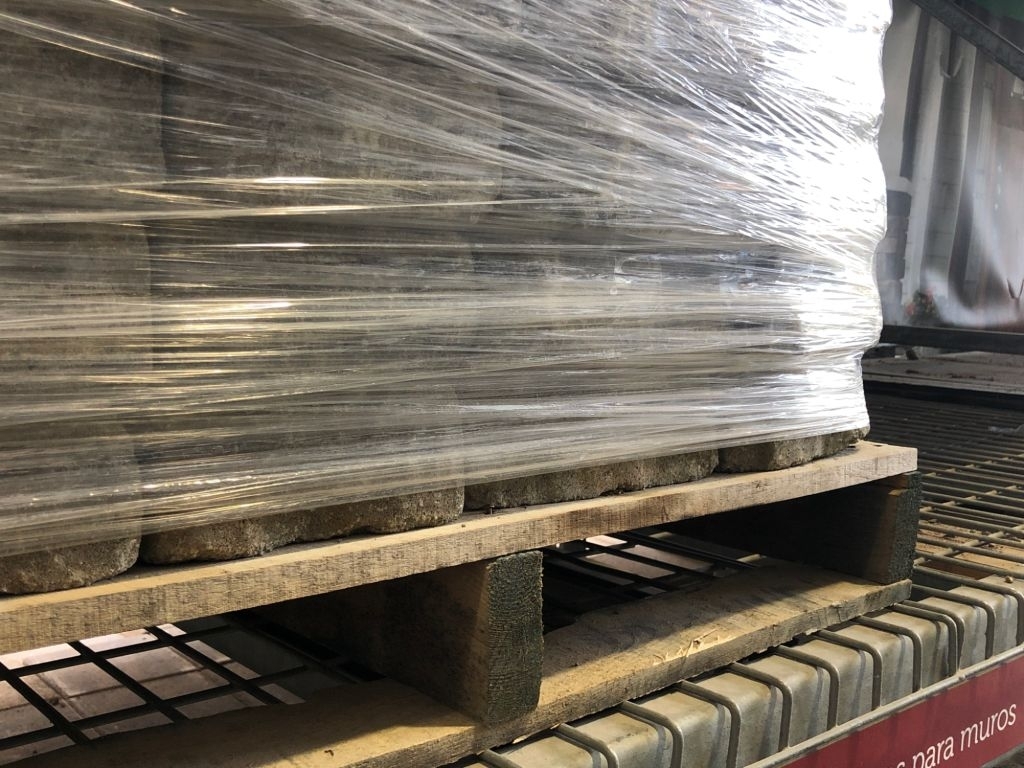Stretch Film Dispensers are plenty in today’s market, but one main problem during the palletization process still exists.
Continue readingWhy Should Your Shipment Be Pallet Wrapped?
Packaging is crucial when transporting goods by trucks, planes and ships to various locations. Factors such as distance, product weight, product volume, product value, and the packaging methodology determine the safety and cost of transportation.
Most shipments are pallet wrapped due to several reasons as discussed in this post. But before we delve in, there is a need to first define the following terms “pallets” and “palletizing”.
What are pallets?
Pallets are plane structures utilized in commercial and industrial establishments to support goods or containers. They help make the movement of goods easier during cargo transportation. The standard size for a pallet is 120×80 centimeters – they are stacked upon cargos in a process known as pelletizing.
Defining palletizing
Palletizing is a process of dispatching cargo safely. During this process, cargos are placed on a pallet and fastened with wraps or straps to hold it firm and stabilize its positioning. The purpose of palletizing is to prevent unwanted movements of goods on transportation systems.
The importance of a packing system
Setting up a packing system will ensure:
- ease for anyone handling the products
- optimization of space and weight
- establishment of a standard of protection that will ensure your product is secured and not damaged
How to build pallets
Palletizing eliminates damage, guarantees a successful voyage, and ensures a professional and timely delivery. If you want to deliver your shipment without hassles, then consider the following methods of building pallets, whether they will be voyaged across the ocean, by air, or land.
- The inside of the pallet should be wrapped using a pallet wrapping machine with high-quality shrink wrap a few times while leaving room for the forklift. Do not cut the stretch-wrap but prepare it when you are done stacking. It’s now time for assembling your boxes.
- Use a flat cardboard slip sheet beneath the load and throughout the layers to help solidify loose boxes and distribute the weight.
- Align your boxes in columns, laying the heaviest on the bottom, corner-to-corner on the pallet to give additional stacking strength. Avoid interlocking or any irregular layer patterns.
- Avoid creating a pyramid, always keep the top layer flat to prevent damage from top loads.
- Do not extend boxes beyond the pallet’s edge else they will get crushed.
- Aligning the corners of boxes in the gaps between pallet boards could risk damage from the forklift, possibly making it immovable.
- For added strength, use cardboard corner-boards at each corner of the entire shipment and a final cardboard slip sheet on top.
- Use pallet stretch film or stretch-wrap you set aside to cover the shipment to stabilize the load.
- Take note that pallet stretch film only stabilizes the load not fully secure it; hence, use nylon straps or bands to tighten the shipment if you observe the need for extra stability.
- Include all necessary documents and affix proper labels to the shipment.
At this point, your shipment is pallet-wrapped and ready to be shipped. Remember to provide guidelines to your packing team to guarantee the safest and easiest handled transit for your freight shipment.
This will help you save cost and help you get your product to your customers undamaged.

Things to know when shipping pallets
The International Organization for Standardization [ISO] has laid down several measures that cater to various aspects of shipping pallets.
- The most commonly utilized pallet size is 48 inches (breadth) by 40 inches (length) and is commonly used in ships in the Northern American shipping zone
- In Europe, the sizes of the pallets used measures approximately 40 inches (breadth) by 47 inches (length)
- The most commonly used pallets in Australia measure 42 inches (breadth) by 42 inches (length)
- Utilization of inferior materials could result in detrimental shipping, which would affect the reputation and credibility of the shipper and the consignor
- Wood is the most commonly used material used for shipping pallets. However, various regulations need to be addressed before a wooden pallet is approved for utilization
- Apart from wood, paper, plastic, and steel are used as viable structures for cargo consignments’ palletizing
The Bottom Line
Transporting goods needs proper containerization to keep them safe. Cargo Shipping and Freight Services are dedicated to providing professional goods and cargo consignments using pallets.
Pallet stretch film is employed to solve issues related to transporting heavy loads, and that is the reason why it is widely used worldwide. For more information, feel free to get in touch with us.
Achieve Your Sustainability Goals & Lower Your TCO with Right Gauging
Achieving sustainability goals is the trend moving forward. Doing so while focusing on lowering the total cost of ownership (TCO) can be daunting. Therefore, in this article, we will talk about using the right gauging to achieve your goals.
Everyone is striving to achieve sustainability goals, albeit a taxing task to balance between business growth and sustainability.
On the one hand, sustainability covers many factors—downgauging, bioplastics, reduction of unsaleables, accidents and wastage, and more.
And can be rather costly at the current stage due to various reasons.
While on the other, the business must continue to grow to thrive.
As such arriving at an equilibrium between these two factors has always been a struggle for businesses.
Downgauging for Business but Not Sustainability
Downgauging can happen through the reduction of film thickness. At the moment, we’re proud to say that Thong Guan can achieve 5-micron “thin” stretch films.
Despite the trend of continuously downgauging to create the thinnest film, we cannot forgo the fact that it poses the threat of constant tearing.
That leads to unwanted downtime at your production floor and unnecessary wastage.
So, the next question is, how thin is thin without having your goods scattered over the roads en route?
This makes matters worse if you’re trying to achieve your sustainability goals.
As such, downgauging is not the only way to achieve sustainability in the bigger picture.
At Thong Guan, we focus on right-gauging to allow you to achieve your sustainability goals while lowering your TCO.
That is why it makes it possible for us to achieve ”thin” stretch films with minimal to zero tearing.
How can we achieve the right gauging for you?
Right Gauging with Big Data
Gauge is the measure of the thickness of your stretch film. And typically, they may range from 37 to 150 gauge (about 9.4 to 38.1 microns).
Thong Guan’s thinnest film by far is about 19.7 gauge, to be exact, 5 microns.
Right gauging is basically finding the right thickness for your application needs.
However, the thickness is not the only factors to consider in the right gauging.
It is when we ask questions like
- What is the weight of your load?
- What is the shape of your load?
- What are the properties of your stretch film? I.e. holding power, prestretch, high-performance, gauge/thickness, types, etc.
As such, it is safe to say, the best way to right gauging is through data.
The Implications of Right Gauging
It is important to understand that a heavier load puts more force on the stretch film.
This means you will need a stronger stretch film.
In terms of holding power, you will need less holding power and durability for uniform loads, for instance, pallets containing boxes of the same size.
On the other hand, you’d require more with irregular and unstable loads.
The heavier the load and the more force the stretch wrap will be under, the stronger your stretch film will need to be.
With the expansive range of our stretch films, you will find different stretch films that come with different properties and holding power.
How does right gauging achieve more sustainability?
It’s simple.
Best-fit film equals stable load.
That translates to lowered risks of load breaking accidents en route, fewer damages to the loads, reduced risks of road accidents, and no more unsaleables.
Do you know that 4% of all transported goods are damaged upon arrival?
And are mostly caused by incorrect wrapping methods.
Perhaps, only downgauging was done and not right gauging due to the pressure to reduce the cost of packaging over time.
As such, films are made inferiors.
That is why at Thong Guan, quality matters to us.
Plus, you can opt for the bio-based stretch film if you’d want to take that extra mile towards achieving your sustainability goals.
How does right gauging help in lowering TCO?
But, that’s not all.
If we look at the entire supply chain and how poor (or good) packaging is impacting your total costs, then you’d probably think twice the next time your Purchasing Department is selecting the films while ignoring the feedback from your head of Production.
This is where Thong Guan comes aims to play a role in connecting your supply chain not just internal but externally through data, and innovative products and solutions.
We do so with the integration of industrial 4.0, the use of big data for smart insights, and superior products that matches your needs.
Testing your wrapping, understanding your stretch film properties, and optimising your entire packaging process flow is the way towards a lowered TCO.
Conclusion
Right gauging with Thong Guan can help you achieve the balance between increasing your bottom line, growing your business while achieving your sustainability goals.
For more info, contact us at info@thongguan.com



